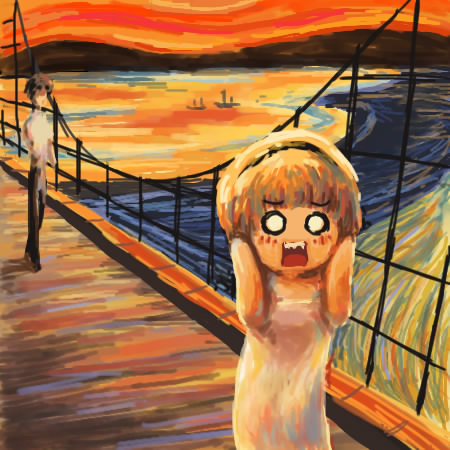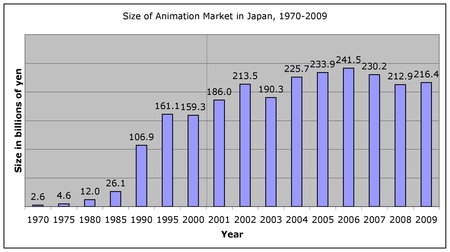
Many people have been talking about the the recent lull in the anime industry, both in Japan itself and abroad. The question is, does this lull spell the doom of anime as some have predicted? Or is it just a temporary setback for an industry that’s too mighty to perish? Well, to answer this question, we need to take a good look at the history of anime. This is an informative ANN article giving a good overview of the size of the anime industry over the last forty years. Of particular interest is this chart, a bar graph representing the growth of the industry since 1970.

What is quickly noticeable is the big boom around 1990, which is the time conventions began popping up in the United States and also when series like Tenchi Muyo and Ranma ½ were being released. Again, the industry sees another impressive climb by 1995, which is when Neon Genesis Evangelion and Ghost in the Shell were released. Moving into the new century, anime received increased exposure on cable television in the United States in the form of Toonami, which featured Sailor Moon, Dragon Ball Z and Gundam Wing starting in the late 90’s, and Adult Swim with Cowboy Bebop, Trigun, Lupin III and FLCL into the early 00’s.
Many of these shows were critically acclaimed and financially successful in North America and the volume and quality of anime being produced and subsequently licensed overseas saw something of a golden age, noticeably peaking in 2006 at nearly 220% higher than just 11 years prior. The future of the industry was bright, many series were being licensed for North America before they even finished their initial television run in Japan, and it seemed like the world couldn’t get enough of Japan’s fastest growing cultural export.
But could the industry maintain that unprecedented success? Find out more after the break!
This Newtype USA ad provides an excellent example of the optimism that permeated the days of the anime boom
However, everything was about to change. In late 2007, Geneon USA collapsed. The details surrounding the corporate mismanagement are vague, but many of their titles had been licensed but never released, and many titles in mid-release were never finished. Geneon had been regarded as one of the highest quality distributors of anime in North America, and the shock-waves reverberated through internet communities and left many nervous and wondering why this had happened to a company that was, by all indications, doing rather well.
In hindsight, we learned that the growth of the anime industry crested in 2006 and has since entered a steady decline, hitting its lowest point in 2008. Economic instability, including a recession in the United States, has likely played a large part in this. It’s no coincidence that the growth of the anime industry exploded when its popularity in the Western market dramatically increased, and it’s no surprise that, as American consumers have less disposable income and the average retail price of a 13-episode series often exceeds US$120, the anime industry would suffer as a result of the economy across the Pacific.
Something else worth noting is that the largest market for anime is shonen and kids’ shows designed to sell merchandise, which recoup their cost through toys instead of home video sales. These are especially vulnerable to an economic downturn because families with children in the home typically have much less disposable income than the 18-35 demographic to whom many of the series mentioned are targeted.
Another factor may be a perceived dip in the quality of material being produced. A series has to make an impression on the viewer in order to compel them to purchase it, and the desire to purchase must be greater than the cost. With a greater perceived cost due to the economy, a viewer will be more difficult to convince and impulse buying will all but disappear. Let’s take a look at some of the notable series that were airing in Japan in 2006, when anime profits reached their highest point in history:
XXXHolic
Ah! My Goddess 2nd season
Utawarerumono
Melancholy of Haruhi Suzumiya
Zero no Tsukaima
Welcome to the NHK
Honey and Clover
Oban Star Racers
Negima!?
Kanon
Death Note
Fate/Stay Night
Code Geass
Higurashi no Naku Koro ni
I could only find sales figures for The Melancholy of Haruhi Suzumiya, which has apparently sold over 4.3 million copies collectively in Japan – this doesn’t even factor in North America. The first two volumes alone had sold 70,000 and 90,000 copies respectively by August of 2006. It’s easy to get caught up in superlatives when talking about the juggernaut that is Haruhi, so I’ll just leave it here.
Many other series were based on manga, games, or light novels which had already become very successful, basically guaranteeing sales for the quality adaptations which were produced that year which created many new fans.
Here are a few notable series which were airing in 2008:
Macross Frontier
XXXHolic Kei
Code Geass R2
Hidamari Sketch x365
Ikkitousen: Great Guardians
Zero no Tsukaima: ~Miyoshi Hime no Rondo~
ARIA THE ORIGINATION
Spice and Wolf 2
Gunslinger Girl : Il Teatrino
Ah! My Goddess : Fighting Wings
Sayounara Zetsubou Sensei 2
Did you notice they are all sequels? While sequels are a wonderful thing in many ways if you’re already a fan, they are a niche market. Only fans already following the storyline will be your target customers for the DVD releases. Even I, for one, would be reluctant to start a series like Macross Frontier in the middle or end of a 25 plus year run.
Moe
You thought you were finally going to get through an anime article without someone whining about moe, didn’t you? I’m sure most of you have already read everything that can be said on this subject elsewhere, but I would like to briefly weigh in on a couple of things.
First, I believe that moe anime are going to go the way of harem shows soon. While you still see harem series popping up occasionally and it remains an element of many good shows, anime primarily focusing on one lonely loser surrounded by pretty girls have largely disappeared. These shows seemed to spawn everywhere after the runaway success of Tenchi Muyo, and likewise moe shows are everywhere in the wake of popular shows like Kanon and Haruhi. Frankly, I’m confident that these shows will not survive much longer because moe thrives on novelty and it has already begun to lose that appeal. The over-production and waning appeal of moe-centric series is likely not helping the overall decline in the industry, either.
Second, I believe that, like the harem mechanic, moe will continue to be part of anime just like it always has. Moe is, by definition, something which appeals to you, and using quirks to endear an audience to a character has been around a lot longer than television.
In conclusion, I believe that a combination of the global economic downturn and creative stagnation has plagued many new releases since 2007. This has resulted in anime failing to maintain the interest of the wider audience it reached in 2006. The average profit of the industry for 2000-9 was only 210.97, so even 2008 was pretty average from a long-term perspective. In any case, it is still much too early to be able to perceive whether or not this trend will continue or if earnings will level off. Every industry has good years and bad ones and a small decline following explosive growth is probably even to be expected, so I don’t think there’s anything to genuinely worry about aside from what we’re going to watch this fall.



